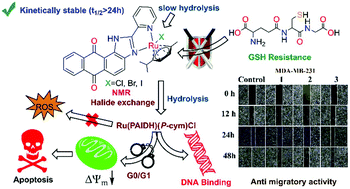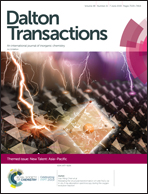Cytotoxic RuII-p-cymene complexes of an anthraimidazoledione: halide dependent solution stability, reactivity and resistance to hypoxia deactivation†
Abstract
RuII-(η6-p-cymene) complexes of anthraimidazoldione (PAIDH) based ligand bearing the formula [RuII(η6-p-cymene)(PAIDH)(X)]+ (where, X = Cl, Br and I) showed excellent in vitro antiproliferative activity (IC50 range 1–2 μM) against hepatocellular carcinoma (HepG2), human pancreatic carcinoma (MIA PaCa-2) and triple negative human metastatic breast adenocarcinoma (MDA-MB-231). The ESI-MS and 1H NMR data show that the complexes are stable in aqueous solution at pH 7.4 (4 mM NaCl) with less than 10% hydrolysis in 24 h. However, when the coordinated halide is bromo (2) or iodo (3), the complex exchanges the halide with chloride in solution. The exchange is dependent on chloride concentration. Fastest chloride exchange was observed for the bromo complex 2 and slowest for the iodo complex 3 showing the higher kinetic inertness of the latter. Complex 3 exhibits the weakest interaction with glutathione (GSH) and 9-ethylguanine (9-EtG) in the series. ESI-MS studies of a 20% methanolic solution of 3 in 4 mM aqueous NaCl showed 80% intact complex even after 24 h of incubation with 9-EtG or GSH. 1–3 show similar in vitro cytotoxicity profile, but based on combined results from solution stability and cytotoxicity, the iodo complex 3 seems to be the best one in the series. There is no deterioration of toxicity under hypoxia or by induction of GSH in HepG2 cells. The low cytotoxicity of the complexes against difficult to treat triple negative breast carcinoma viz. MDA-MB-231 in vitro (IC50 = 1.5 ± 0.1 μM) is very encouraging, compared with cytotoxicity of clinical drug cisplatin (IC50 = 37.2 ± 2.5 μM). The complexes can alter mitochondrial membrane potential, arrest the cell cycle in G0/G1 phase and kill cells via apoptosis. They inhibit migration of the metastatic MDA-MB-231 cells at IC20 dose.

- This article is part of the themed collection: New Talent: Asia-Pacific


 Please wait while we load your content...
Please wait while we load your content...